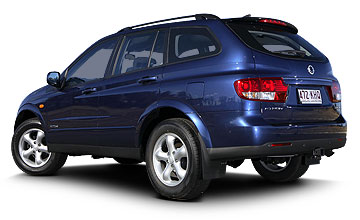BY PHILIP LORD | 24th Sep 2007

Whittling down to the detail, changes have been made to the bonnet, front guards, grille, bumper and lights. At the rear, the tailgate is new, as are rear quarter panels, bumpers and lights. The 18-inch wheels are also a far more simple, elegant design.
So the Kyron has been made cleaner and cheaper and is certainly much better to look at. But is it any good?
Slide into the cabin and the black chequered seat trim looks better than the unimpressive grey material used before and the general impression is of a clear, very conventional well laid-out dash.
The only odd detail is the digital clock, which has the hours displayed above the minutes in a vertical stack.
Look closely and you’ll notice that you don’t get a luxury SUV for the price of an entry-level model.
Some of the interior is a little rough around the edges (the new illuminated vanity mirrors, for example don’t quite have the expensive look of some of the other parts of the dash), and the sword-shape handbrake lever is set over to the left on the centre console - not an ideal position for the driver in right-hand drive cars. The cargo cover on the M270 XDi looks cheap, too.
The Kyron’s seats are not remarkable in the class but are comfortable nonetheless, seeming to be able to provide adequate support for most shapes and sizes (no easy feat), and offers a sound driving position aided by the height-adjustable steering wheel (there's no reach adjustment) and height-adjustable seat base.
There is no driver’s left footrest, even though there is the room to fit one. SsangYong locally says it would like to fit one here, but faces problems with crash worthiness if it does so.
Rear seat comfort is quite good, with lap-sash belts for all occupants, while cargo space is easy to access with the lift-up tailgate that presents a tall and wide if not particularly deep load space.
The view out of the Kyron is clear until you scan behind you, where the thick D-pillars and small rear window (even though it’s supposed to be larger) make seeing much harder. At least the Kyron has rear-parking sensors to take some of the guesswork out of reverse-parking manoeuvres.
Both the 2.0-litre and 2.7-litre turbo-diesels are relatively quiet, smooth performers but the muted rattle seeping into the cabin leaves no doubt in anyone’s mind that they are diesels. The better performer is clearly the 2.7-litre, which lacks the low-rpm tardiness that the 2.0-litre suffers from.
Neither engine feels all that punchy compared to the better turbo-diesel efforts in the medium SUV sector, but there is enough torque there once you look for it.
The automatic transmission, a Mercedes-Benz five-speed unit, has nicely spaced ratios and serves up a smooth gearshift. The new gearshift buttons on the wheel are an easy, welcoming entrée to self-shifting, quickly becoming second nature unlike other more awkward set-ups.
The Kyron is a relatively old-school SUV in its suspension and chassis, with an independent coil spring front suspension and five-link coil spring live axle at the rear. The separate chassis and neatly tucked-up or bashplated underpinnings generally augur well for the inevitable off-road biffs.
This design may promise a polished off-road performance but unfortunately the Kyron borders on truculent when pushed on the road.
It’s worth briefly revisiting the last Kyron’s suspension to understand the new one.
The superceded Kyron appeared as if SsangYong’s engineers set very narrow targets with ride, NVH levels with the previous Kyron. Get it out on a relatively smooth highway, and it was quieter and smoother than many competitors.
As soon as sharp potholes or ripples became part of the equation though, the Kyron’s soft springs and dampers left it thumping and bouncing about.
The fix with Euro IV Kyron has been to install stiffer dampers, which in tandem with fairly grippy tyres works well enough on smooth roads, allowing the Kyron to be driven enthusiastically in twisty sections of ripple-free road, even if the way it tracks and steers doesn’t exactly have the driver begging for more.
On rough roads, it is a very different story. While the prior model would absorb the initial bump shock and take a while to recover from it, the new dampers don’t entertain such road shocks at all well.
The initial damping seems too firm and once it actually gets past this initial stiff compression point, the springs seem too soft. The net result is that the suspension feels uncomfortably firm and causes the vehicle to feel unstable as it skitters over bumps.
The Kyron is a worthy alternative to the Japanese mainstream with its blend of packaging and performance and, now it can be said, its innocuous styling.
But its suspension is its downfall.
While a good aftermarket set-up would probably sort it out, other Koreans with similar chassis and suspension design such as the Kia Sorento and Hyundai Terracan show that it can be done better than this, straight out of the box.